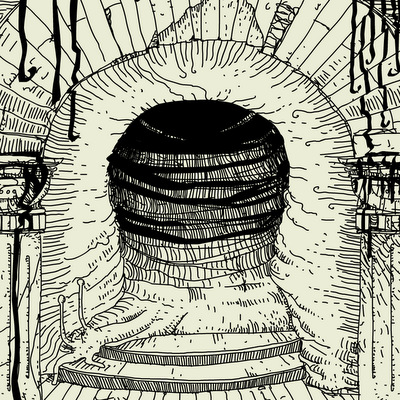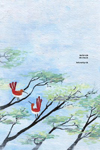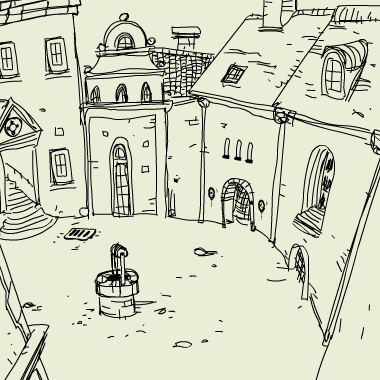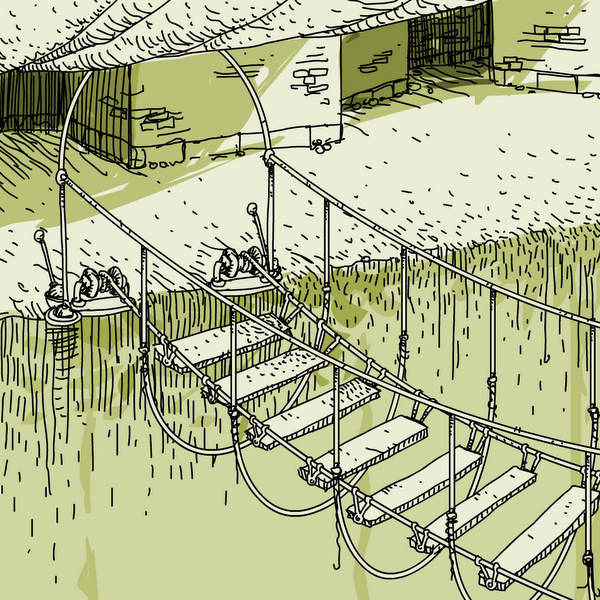dmt4 – the entrance
August 16, 2013

Step right up into the darkness, kids. Nothing to be afraid of here. There’s a certain feeling of deja vu in this place. I feel I’ve been here before. Like in DMT2…

 Most of the time I would much rather play video games on my consoles and on my handheld systems, but I will admit that there are a few moments when I feel like playing some flash games online. A site I like to go to to experience these online games is One More Level, and recently I’ve discovered a couple games that have immediately piqued my interest and have quickly become enjoyable to me (and have become some of my favorite Flash games next to theFancy Pants games). One of the two titles is called King’s Ascent, which I’ll talk about one of these days, and the other one, which I’ll talk about right now, is a fascinating title calledDaymare Cat. Given that it itself is a part of a series, I won’t compare it to the other titles since I haven’t played those, so I’ll just discuss about this individual game on its own merits.
Most of the time I would much rather play video games on my consoles and on my handheld systems, but I will admit that there are a few moments when I feel like playing some flash games online. A site I like to go to to experience these online games is One More Level, and recently I’ve discovered a couple games that have immediately piqued my interest and have quickly become enjoyable to me (and have become some of my favorite Flash games next to theFancy Pants games). One of the two titles is called King’s Ascent, which I’ll talk about one of these days, and the other one, which I’ll talk about right now, is a fascinating title calledDaymare Cat. Given that it itself is a part of a series, I won’t compare it to the other titles since I haven’t played those, so I’ll just discuss about this individual game on its own merits.
In this game you control a girl who must navigate around this building based on an Arabian design and find her way outside to freedom. However, before that can happen, you must solve every puzzle that is laid out for you. There is a door in the center of the building that will lead you outside, but the only way it will open up is you find and play a record on all five record players. The building has got some complex design, interior-wise, as a lot of the times it looks like the inside of a building, but at times there are moments when you slip inside caves and dark areas, and you are required to use certain items in certain locations in order to reach certain points. Daymare Cat solely requires the use of the four arrow keys, so it’s simple yet intuitive. You can move to both the left and the right, jump with the Up button (you can hold it to jump indefinitely), and to enter doors and/or use specific items you press Down.
What really stands out aboutDaymare Cat are its visuals plus its sense of atmosphere. The visuals are remarkable to say the least, even though they are not at all colorful (in fact, it’s all sketches) they are thoroughly detailed. The sketches in each screen are drawn so well and evoke a real sense of variety. Take for example a cave where it’s all so dark save for the inside walls, and then you find yourself in a carefully structured room, and for a last example there is a moment when you’re in a very dark building where everything is dark save for the lights that emit from the small holes. I could name more examples, but there are just so many to name and I feel it gives an overall surreal quality to the experience. The animation is detailed, the various areas are wonderful yet sometimes weird, and there are some moments when the camera will zoom way out when it comes to larger areas. This is one those games where there is no scrolling involved but instead has the character transition from screen to screen, a la Prince of Persia.
Another quality that works to its advantage is its atmosphere, and for a large portion of the game there is nothing but ambience in the background, that is until you play a record you found on a record player. There are five record players in the game, and any time you play one you’ll hear a different rendition of the same song; one variation will be vocals while another one would be drums, to name a couple. However, those only last for about a minute, and then once the recordings are done its back to the ambience. Once you go through the door and beat the game you’ll hear all five variations of the song together, forming one beautiful-sounding song by Cat Jahnke; the lyrics themselves are very nice. Another aspect that makes this game wildly atmospheric and ambient is that sound effects are few and far between, and when they are heard they’re a treat to listen to.
Due to how the game was structured it is so easy to become engrossed in its fascinating-looking world, and it’s a real treat for the eyes and the ears. One thing that makes this game stand out from the rest is that it’s short. And by that, I mean if you’ve mastered and memorized every location then you’ll be able to beat it in just a matter of minutes. I should be upset about the incredible brevity, but surprisingly I’m okay with that. I like the way that the game ends, and I also like creative energy behind these neatly designs segments of the game. Daymare Cat ends on a pretty ambiguous note, I should add, and it really leaves you wondering what’s going to happen afterwards. Granted, I’ve yet to try any of the other Daymare titles, so I’m not very familiar with the series. But from what I’ve played here, I found it to be pretty enjoyable and entertaining in its own right. Even though it is incredibly short, I do applaud its nonlinear style (a la Metroid and Cave Story) of gameplay, not to mention its a very charming flash game that really sticks with you, atmosphere-wise. It’s not a game you’ll find yourself playing every day (so don’t expect something challenging and overly difficult), but should you be in the mood for something short and sweet, I think you’ll get a kick out of this game. I know I did. =)
7.5/10
P.S.: I normally don’t review flash games, but I’m glad I got to review this one. =)
author: StarBoy91
 Swego czasu pewna irlandzka wokalistka dała się namówić na skomponowanie utworów do poszczególnych epizodów pewnego serialu dokumentalnego. W efekcie powstała płyta, za sprawą której wspomniana wkroczyła na ścieżkę solowej kariery, dorobiła się pokaźnej fortuny, własnego zamku oraz światowego rozgłosu.
Swego czasu pewna irlandzka wokalistka dała się namówić na skomponowanie utworów do poszczególnych epizodów pewnego serialu dokumentalnego. W efekcie powstała płyta, za sprawą której wspomniana wkroczyła na ścieżkę solowej kariery, dorobiła się pokaźnej fortuny, własnego zamku oraz światowego rozgłosu.
Trochę podobnie rzecz się ma z Mateuszem Skutnikiem, który globalnej sławy póki co jeszcze się nie doczekał (a czego piszący te słowa szczerze mu życzy), ale też dał się wciągnąć w podobny „układ” jak rzeczona artystka. Bowiem na jednym z wiodących forów, uczęszczanych przez komiksową brać, partycypował w cotygodniowym konkursie na jednoplanszową opowiastkę. Kumulacją całorocznego trudu jest pełnowymiarowy album zatytułowany po prostu „Tetrastych”, który to wyraz zwykło się przekładać po naszemu jako „czterowiersz”. Nieprzypadkowo zresztą, bo konkursowe cugle ograniczały uczestników artystycznych szranek do zaledwie czterech kadrów.
Tym sposobem Mateusz Skutnik, choć w mocno zmodyfikowanej formule, nawiązał do tradycji ś.p. Janusza Christy, który również miał w zwyczaju tworzyć „czterowiersze” na potrzeby „Wieczoru Wybrzeża”. Efekt finalny prezentuje się co prawda odmiennie od zwykle piętrowych, ściśle powiązanych ciągiem fabularnym opowieści mistrza z Sopotu, trudno jednak odmówić zawartym tu opowiastkom (choć niekoniecznie wszystkim) błyskotliwego humoru. Swoje cele Skutnik osiąga w różny sposób. Dominuje jednak groteska („Pożegnanie”) oraz pastisz („Zimno”). Przy czym frajdą samą w sobie jest okazja do prześledzenia ciągu skojarzeń autora – zwykle nieszablonowych i w bogactwie swej inwencji pozytywnie zaskakujących.
Recepcja poszczególnych „czterowierszy” zależy rzecz jasna od rozrywkowych preferencji potencjalnego odbiorcy albumu. Wielbiciele wisielczego humoru być może odnajdą coś dla siebie przy okazji lektury m.in. „Ognia”, „Gry cieni” czy „Chusteczki”. Nie obyło się również bez mile widzianych w tzw. wyszukanym towarzystwie zgryźliwości pod adresem chrześcijaństwa („Święty”, „Islam”). Nie jest to zatem dziełko światopoglądowo zdystansowane, choć w swojej klasie całkiem zabawne.
Plastyczny styl Skutnika cechuje przede wszystkim wrażeniowość i zamiłowanie do operowania rozmytymi akwarelami. Okrzepła w toku kilkunastu lat twórczości maniera rzeczonego prawdopodobnie nie wszystkim przypadnie do gustu. Współautor „Morfołaków” zdaje się zwykle preferować barwny monochromatyzm udanie podkreślający nastrój rozrysowywanych scen. Tak też bywa tutaj, choć gwoli ścisłości zdarzają się także plansze kolorystycznie bardziej zróżnicowane. Całość znamionuje realizacyjny pośpiech, ale też ekspresywna improwizacja charakterystyczna dla warsztatowego ćwiczenia.
Na swój sposób wiele mówiącym zabiegiem jest kompozycja na okładce dalece odbiegająca od tradycyjnie pojmowanej okładki komiksowego albumu. Miast tego wzbudza skojarzenia raczej z tomikiem haiku tudzież książeczkami dla dzieci ilustrowanymi przez przejawiających awangardyzujące ambicje plastyków. Nieprzypadkowo, bo Skutnika raczej trudno uznać za typowego wytwórcę historyjek obrazkowych. Dał temu wyraz m.in. w swoim sztandarowym cyklu „Rewolucje”. Zresztą ta na swój sposób zastanawiająca tendencja przejawia się nie tylko w jego dorobku, ale też u co najmniej kilku innych aktywnych obecnie twórców. Przy czym trudno wyzbyć się odczucia ich ucieczki od jednoznacznie kojarzącej się z komiksem estetyki. W pełni zrozumiałą tendencją jest pęd autorów ku nowym odmianom artystycznej ekspresji. Niemniej równocześnie może wytwarzać pozory odcinania się od korzeni gatunku na rzecz poszybowania ku bardziej rokującym dotacyjnie obszarom stylistycznym.
Przemysław Mazur
 Mateusz Skutnik znalazł bardzo dobry sposób na to, żeby zmotywować się do stworzenia cyklu krótkich form komiksowych. Po prostu przez rok czasu brał udział w organizowanym na forum portalu Gildia.pl konkursie na pasek komiksowy. Kiedyś w tym samym konkursie, tyle że organizowanym na niefunkcjonującym już forum agencji prasowej Wrak.pl, regularnie pojawiał się Blaki. Efektem tego był album zbierający jego zamknięte zwyczajowo w czterech kadrach perypetie z życia wzięte. Teraz na papier trafiły najnowsze paski artysty z Pomorza, a opublikowało je Wydawnictwo Komiksowe.
Mateusz Skutnik znalazł bardzo dobry sposób na to, żeby zmotywować się do stworzenia cyklu krótkich form komiksowych. Po prostu przez rok czasu brał udział w organizowanym na forum portalu Gildia.pl konkursie na pasek komiksowy. Kiedyś w tym samym konkursie, tyle że organizowanym na niefunkcjonującym już forum agencji prasowej Wrak.pl, regularnie pojawiał się Blaki. Efektem tego był album zbierający jego zamknięte zwyczajowo w czterech kadrach perypetie z życia wzięte. Teraz na papier trafiły najnowsze paski artysty z Pomorza, a opublikowało je Wydawnictwo Komiksowe.
Tematyka pasków zebranych w „Tetrastychu” jest tak różnorodna, jak tylko może być. Autorzy biorący udział we wspomnianym konkursie wymyślają czasem bardzo ograne (m.in. jesień, złoto, ptaki), a czasem udziwnione (m.in. trzy kwadraty, gadka szmatka) tematy, a do tego dochodzi jeszcze sposób, w jaki podejdzie do nich artysta. Skutnik niektóre z tematów potraktował bardzo dosłownie, niektóre zaś zupełnie niebanalnie. I dlatego, jak na antologię tego typu przystało, z jednych można się śmiać, inne mogą skłonić do jakieś krótkiej refleksji, a jeszcze inne mogą zostać niezrozumiane. Co by jednak o nich nie mówić, na pewno jest to ciekawy zbiór twórczości jednego z najbardziej wyrazistych polskich autorów, który nie zwykł schodzić poniżej pewnego poziomu.
W „Tetrastychu” Skutnik odszedł od znanych z „Rewolucji” charakterystycznych ludzików. Postaci pojawiające się w jego paskach nie przypominają też pod żadnym względem Blakiego. Umowny świat, budowany co tydzień w zasadzie na nowo, z jednej strony zachwyca swoja różnorodnością, z drugiej strony widać, że niektóre paski powstały raczej na szybko, a do innych przyłożono trochę więcej atencji. Da się wyczuć, że były one pewnego rodzajem polem do twórczych eksperymentów, rozrysowania się, popróbowania pewnych rzeczy, wreszcie zmierzenia się po raz kolejny z wcale nie łatwą sztuką opowiadania historii w zaledwie czterech kadrach. Moim zdaniem zabawa zakończyła się sukcesem.
Kolorowe światy z wyobraźni Mateusza Skutnika warte są eksploracji. Można wśród nich znaleźć kilka prawdziwych komiksowych perełek. Jedna z nich to chwytająca za serce historia gońca (skoczka), figury szachowej o kształcie konia, opowiedziana w pasku pt. trzy kwadraty. Prawdziwy majstersztyk. Zresztą nie jedyny, jest takich więcej. Dziś jednak próżno szukać ich w archiwach internetowego forum z konkursem na pasek komiksowy, teraz są dostępne jedynie w wersji papierowej. Aby je zdobyć, warto udać się do księgarni.
Jakub Syty
 Where The Sidewalk Ends.
Where The Sidewalk Ends.
Daymare Cat aims to pique your curiosity with Shel Silverstein style.
“Never explain what you do,” said Shel Silverstein, likely the coolest bald poet of all time. “It speaks for itself. You only muddle it by talking about it.” Mateusz Skutul clearly took Silverstein’s maxim to heart when he created Daymare Cat. This black-and-taupe storybook of a game says very little to the player out loud beyond simple directions. Instead, it lets its strange world speak for itself.
As a young lady with a billowy dress and long ragged hair—as if she were pulled straight from a Neil Gaiman fan’s notebook—you’re trying to open a Persian-style door in a wind-blown, silent city. There’s no one else in town, and it isn’t clear how to open the door since there’s no keyhole, just a series of five pipes above it. As you wander through the city, jumping over bottomless pits, you’ll spot objects that are clearly tools to help move you closer to opening that door. Reaching them is a matter of inspecting the lovely, detailed architecture surrounding you. Details that seem like nothing but stylistic flourishes in the setting are often new paths, and discovering each one is delectable because there’s always something unique waiting on the other side. Through exploration and discovery, it soon becomes clear how that big, fancy door opens.
Daymare Cat’s success is how it tweaks curiosity then rewards indulging that curiosity with strange visions and song. More importantly, as Silverstein advised, it never explains what it does.
By Anthony John Agnello • July 1, 2013
There is a pressing question hanging over my head and I want to address it today. Daymare Town 4. Why does it take so long?… Actually, this can be answered quite simply. Just take a look at these two pictures:
This is Daymare Town 1:

And this is Daymare Town 4:

I think those two pictures are quite self explanatory. It takes time, because DMT1 was done 6 years ago, and it was just a side sketch project. Since then it grew to become arguably my most important world and the best series of games. And while the submachine world is kind of closed in it’s mechanics and structure, the daymare world proved to be flexible and able to contain different gameplay architectures. Yes, latest addition of Daymare Cat kind of paved the way of evolution of this series. More on that in 2014.
Now. If you looked at those pictures above and still said to yourself: “So? Why does it take so long?…” – then I DARE you to watch this video and actually sit through it till the end. This is a stream of me creating the above picture.
After you’ve watched it – realize that this is just one location in a game that contains over 100 of them. True, not all of them are so complex, but any one that’s still not drawn COULD be, if you know what I mean. And this is not 9 to 5 job either. This is what people call creative work. It can’t be done on the clock.
So, after all this, if you’re still asking why does it take so long and WHEN the game’s going to be ready, then… uhm…. no, I’ve got nothing for you.
Or you can watch this.

DAMMIT! Why did I pick up the color brush today, instead of just sketching that new daymare game – as usual… Not that I’m on the fence about this one right now, not at all. DMT4 is coming up with the usual color pattern (meaning – pattern almost non existent), but…. this looks fine…
Oh well, I guess this is the POSSIBLE way the Daymare franchise might evolve in time. Move over Steam games, I’m coming.